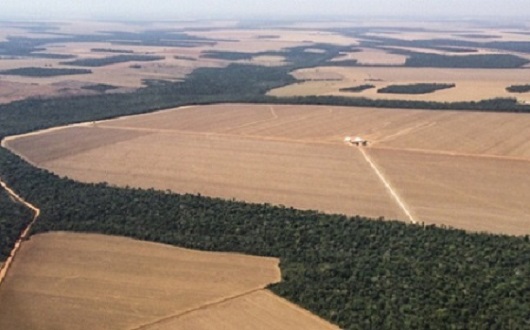Climate change and savannization of the Amazon will impact populations due to heat
05/10/2021
Oswaldo Cruz Foundation (Fiocruz) and National Institute of Space Research (Inpe)
Large-scale deforestation of the Amazon forest associated with climate change will increase the risk of exposure to extreme heat. Such levels of heat, which will be physiologically intolerable for the human body, will profoundly affect regions inhabited by highly vulnerable populations, according to a study published by researchers Beatriz Alves de Oliveira, of Fiocruz; Marcus Bottino and Paulo Nobre, both of the National Institute of Space Research (INPE); and Carlos Nobre, of the Institute for Advanced Studies of the University of São Paulo (IEA/USP). This is the first analysis of the combined impact of deforestation and climate change on human health.
Photo: Courtesy
According to the results of the study, deforestation and climate change project an increase in the risk of thermal strain in the Brazilian Amazon. There is a limit to the deforestation the Amazon can sustain before impacting the survival of humankind. This threshold is accompanied by an “extreme effect on health” which by the year 2100 will leave more than 11 million people in the North Region of Brazil exposed to an extreme risk of thermal strain, once we reach the thresholds of physiological adaptation of the human body due to deforestation. In other words, we will no longer be able to maintain our body temperature without adaptation.
The researchers emphasized the urgent need for coordinated measures to avoid negative effects on vulnerable populations. “The local effects of changes on how the land is used are directly related to the policies and strategies of sustainability of the forests, and changes in these areas are within reach of the society. In these areas, the health sector might be an important drive to formulate integrative policies to mitigate the risk of thermal strain and to reduce social vulnerability”, states Beatriz Oliveira, researcher of Fiocruz Piauí.
Deforestation and increase in body temperature
Under unfavorable environmental conditions that include high exposure to temperature and humidity, the cooling ability of our bodies is weakened, resulting in an increase in body temperature. Sustained exposure to such conditions may result in dehydration and exhaustion and, in more serious cases, tension and collapse of body functions, leading to death. In addition, the stress caused by heat may affect mood and mental disorders, and can hamper people’s physical and psychological performance.
“Extreme heat conditions induced by deforestation may have negative and significantly long-lasting effects on human health. We need to understand, from a global perspective, that if deforestation continues at the current rate, effects for humankind will be dramatic. These discoveries have serious economic implications that go beyond damages to soy plantations”, states Paulo Nobre, of INPE.
In Brazil, the combined effects of deforestation and climate change are already being reported based on observational data, with more extreme heat values reported in large areas that suffered deforestation between 2003 and 2018.
In the climate models made by the researchers, the combination of changes in how the land is used and global heating may further increase occupational hazards. In addition, factors induced by humans responsible for the savannization of the Amazon forest, such as more forest fires and expansion of areas of agriculture and mining activities, tend to lead to disordered growth and to a process of unplanned urbanization, with insufficient basic sanitation infrastructure and more frequent informal work. These factors are associated with the process of deforestation and an increase in inequality and vulnerability, which act in synergy with the effects of climate change, further increasing the demand for healthcare and social protection in the region of the Brazilian Amazon.
Impacts on economy
The results of the study show that the effects will have a regional scale, with the highest impacts occurring in the North region of the country. Of the total of 5,565 municipalities in Brazil, 16% (30 million people) will suffer the impact of thermal stress with the savannization of the Amazon Forest. Of the impacted population, 42% reside in municipalities in the North Region; these populations have low resilience capabilities and high social vulnerability. In this region, approximately 12 million people may be exposed to the extreme risk of stress by heat by 2100. With the savannization of the Amazon and the limitations in the adaptation capacity of the North Region of Brazil, the population in this area may end up living in precarious survival conditions, leading to effects such as mass migration, according to the authors.
In addition, increased exposure to thermal stress may impact various areas of the economy, with a reduction in work productivity, as workers will be exposed to fatal temperature conditions. In Brazil, outdoor workers are already exposed to this kind of stress, and projections point to an increase in high-risk exposure in the upcoming decades. An increase of 1.5° C in the global average temperature, based on the projections of the researchers’ climate models, may result in 0.84% of lost working days by 2030, the equivalent of 850,000 full-time jobs, especially in agriculture and in the construction industry - in agriculture, the high risk associated to intense labor and heat overload has already been observed in sugarcane cutters.
The reaserchers’ estimates do not take into account populational growth or changes in the demographic structure or in life expectancy. Therefore, the results exposed in the study reflect the isolated effects of climate change and savannization, and can be interpreted to represent the effects that would be observed if the current population was exposed to the projected distributions of thermal stress. The vulnerability of exposed populations was evaluated through the Social Vulnerability Index (SVI) of Brazilian municipalities. This index is based on 16 indicators that reflect fragilities in the health and education systems (human capital), urban infrastructure, income, and work.


